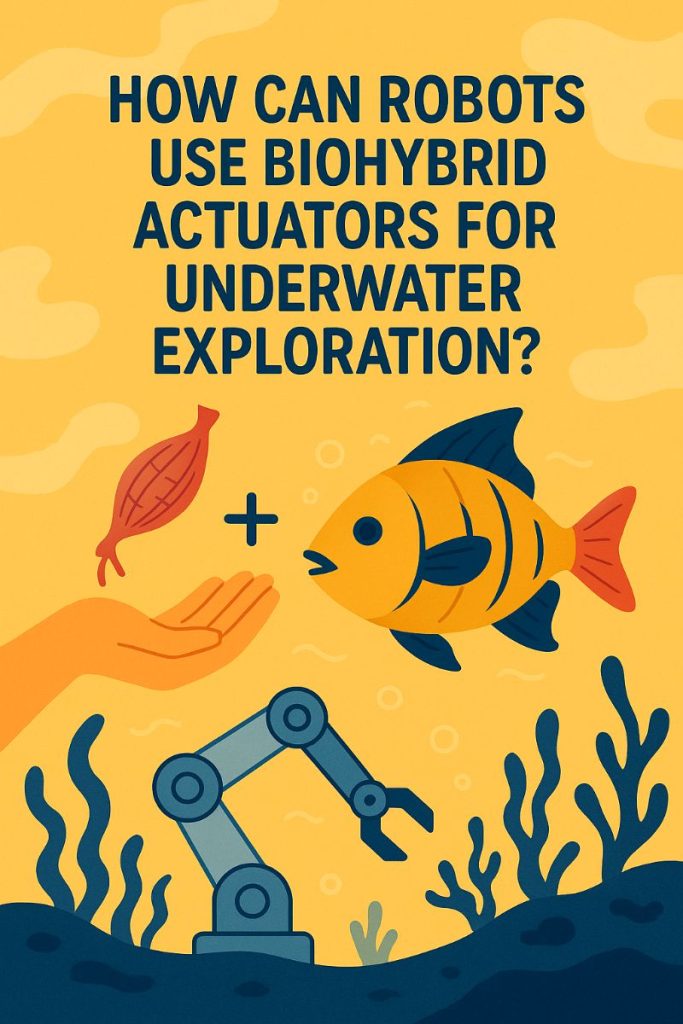Table of Contents
Wait, what the heck are biohybrid actuators?
So, why should robots even go underwater?
Robots + muscles = underwater magic?
The fishy inspiration behind it all
But like, what’s actually inside these actuators?
Squishy tech is the future (don’t @ me)
Real talk: where’s all this happening right now?
Why this matters (especially if you’re a startup)
Underwater robots meet photonic computing? Oh boy.
Wrapping it up: What’s next for underwater bots?
🔥 FAQs – Real questions, real talk
1. Wait, what the heck are biohybrid actuators?
Alright, let’s break it down.
“Biohybrid actuators” sounds like something out of a Marvel movie, but really, it’s just science smashing together biology and tech to make robots move in more natural, flexible ways. Think: muscles. But not inside you. Inside machines.
Like… imagine if a robot fish didn’t just act like a fish, but swam like one because it literally had muscle fibers that flexed like the real deal. Kinda wild, right?
2. So, why should robots even go underwater?
Short answer? Humans aren’t exactly built for deep sea hangouts.
There’s pressure (like actual physical pressure, not just existential dread), zero visibility, and all kinds of creepy-cool things crawling around.
But robots? They don’t mind. And if you give ’em the right gear (like biohybrid actuators), they can go way deeper and move way smoother. Like underwater ninjas. 🐙
3. Robots + muscles = underwater magic?
Yup. Here’s the thing—most robots move like… well, robots. Clunky. Jerky. Not ideal when you’re swimming next to a coral reef or trying to study a rare jellyfish without scaring it off.
Enter biohybrid actuators. These bad boys mimic actual living muscle. So instead of a stiff robotic arm, you get a soft, flowing, muscle-powered movement. Graceful. Precise. Like a ballerina. But wetter.
4. The fishy inspiration behind it all
Not joking—biologists and engineers have been straight-up studying fish and octopuses for this stuff.
Octopuses are basically shape-shifting water wizards. They squeeze, stretch, bend in all directions. Engineers went, “What if we could make a robot do that?” Boom. Biohybrid tech was born.
Fish tails, squid arms, sea slug wiggles—you name it, there’s probably a lab trying to copy it right now.
5. But like, what’s actually inside these actuators?
Alright, imagine a soft sleeve, like a gummy worm, but inside? Living cells. Often from real muscle tissue. And when you zap it with a little electricity? The thing moves.
Some versions use lab-grown muscle cells. Others use synthetic stuff that behaves like tissue. Either way, they’re squishy, responsive, and eerily lifelike. No clanking metal joints here.
Wanna go full-nerd? Check this out on topological optimization for robotic exoskeletons. It’s related. It’s genius.
6. Squishy tech is the future (don’t @ me)
This isn’t just underwater robots. The whole robotics field is going soft. Literally.
Why? Because soft robots don’t break as easily. They don’t crush stuff they touch. And they can wiggle into tight spots. Which is kinda essential if your job involves spelunking inside shipwrecks or under icebergs. ❄️
It’s part of this whole wave of bio-inspired tech. Like how photonic computing is speeding up robotic vision. Wanna go down that rabbit hole? This article slaps.
7. Real talk: where’s all this happening right now?
Universities, research labs, DARPA projects… and yeah, startups are getting in on this too.
There’s this crazy crossover happening between biotech, marine robotics, and AI. Like, robots that learn as they move. And they share their “brain” data across fleets without breaching privacy—yep, federated learning explained here.
This stuff ain’t sci-fi anymore. It’s happening.
8. Why this matters (especially if you’re a startup)
If you’re building tech—especially for exploration, marine biology, environmental monitoring—this is the edge.
Biohybrid actuators give you movement that’s subtle, controlled, natural. Your robot doesn’t just exist in nature—it blends in.
Less disturbance = better data. Also? It just looks freakin’ cool. Investors like cool.
9. Underwater robots meet photonic computing? Oh boy.
Imagine a robot fish that’s not just swimming around—it’s seeing like a hawk underwater and processing all that data faster than your laptop on a good day.
That’s where photonic computing steps in. When you marry that with biohybrid movement? Oof. Game changer.
10. Wrapping it up: What’s next for underwater bots?
Biohybrid tech is still in the “Whoa, cool!” stage. But it’s fast becoming the “Let’s use this for real work” stage.
Soon, we’re gonna see underwater robots that aren’t just tools—they’re teammates. Helping with coral reef mapping, wreck site recovery, even deep-sea mining. All while moving like they belong in the ocean.
Soft robots. Smart sensors. Living muscle. Wild, huh?
🔥 10 Human-Friendly FAQs About Biohybrid Actuators
1. What are biohybrid actuators, like… really?
They’re squishy robot parts made from actual living cells or soft synthetic materials. Basically, muscles for machines.
2. Why do we need them underwater?
Because old-school robots are awkward and stiff. Biohybrid ones swim like fish. Literally.
3. Do these robots feel pain?
Nope. No nervous systems. Just muscle cells doing their thing.
4. Can these robots heal themselves?
Some early research says yes! Like starfish. It’s still experimental though.
5. Are startups actually using this?
Some cutting-edge ones are. Especially those in marine biotech or defense.
6. Is this tech expensive?
Right now? Kinda. But as with everything, mass production will drop the cost.
7. Can this work in space too?
Actually… yes. Some labs are looking at similar tech for microgravity 3D bioprinting.
8. How are these powered?
Usually low-voltage electrical stimulation. Like tickling the muscle.
9. Could this replace prosthetics someday?
That’s the dream! Soft, lifelike motion could be a game changer in medtech.
10. Is this creepy or cool?
Depends who you ask. We say: mostly cool. With just a hint of sci-fi chills.

